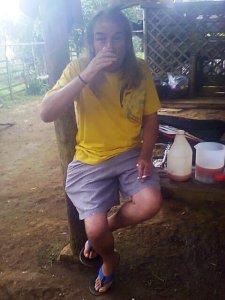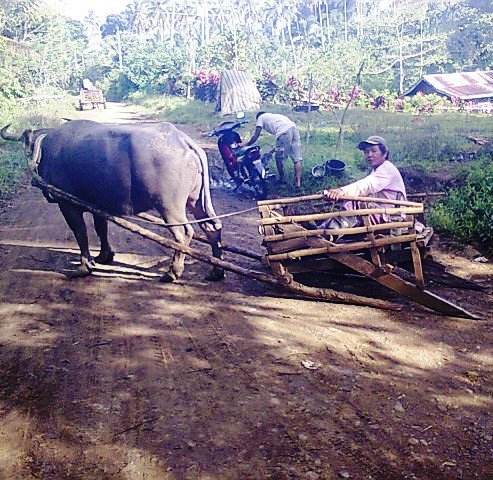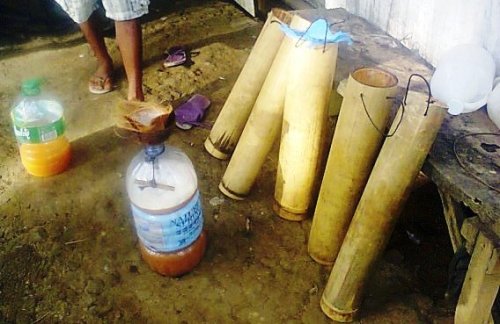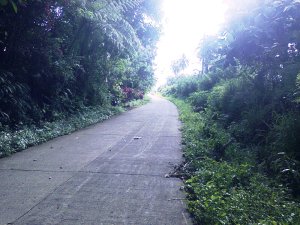After the second of my two 4-month stays, I decided to leave Catigan not sure what the future would hold. I went back to Metro Manila. I was not happy to be away from the peace and quiet of Catigan but delighted to be able to get back into my city ways. I had learnt to live without many things whilst I was away but none of that means I didn’t miss having a more convenient and easier life by being in a city.
I’m a city boy and I guess if you’re city-orientated from birth then you are always going to feel more at home with what you’re used to. The eight (8) months I spent in Catigan was my first real taste of rural Filipino life. I was quite pleased with myself that I did adapt over time and once you stop missing things you think you need, you learn that really you don’t need much.
Understanding the WTF Factor
This project of mine is about trying to show varying sides of Filipino life. It’s done in a totally amateur way with lousy photos taken on a cell phone and being broke means I live in a way most foreigners wouldn’t want to which in turn brings me face to face with some of the hardships that many everyday Filipinos have to endure. I don’t have the resources to venture into surrounding resorts nor food taste in restaurants. I bloody well want to and dream of that day ever happening. I give a perspective from places many outsiders would not want to bother with. Not entirely by choice but as that’s how it is for me: I embrace it, learn from it and share it.
The reason I’ve sub-headed “Understanding the WTF Factor” is because although some people are aware of how life is here for many, it still comes as a bit of a surprise when you venture into the everyday world of the Filipino. The more you learn, the more you realise just how life is hard for so many every day. Most get by with little and they live and eat daily. As you venture into cities and in the countryside, you experience situations where you find yourself asking, “How do they survive it?”
Time possibly hardens you as you become used to it. For newbies, it’s inevitable that on several occasions, you will find yourself exclaiming “WTF?!” It’s something only those that have travelled extensively around the third world would not be a little overawed by the lack of opportunity and the difficulties they endure. It’s not every Filipino of course but still many more than any official stats would suggest live lives unimaginable by anything the average westerner is accustomed to. The Philippines is not just a country with some in poverty, it’s a country of mass poverty.
For us, it is culture shock as well as astonishment at the patience these people have even damned stupidity of how they don’t fight back. Time teaches you why they don’t. We as westerners would probably make discord and find scapegoats as we do that in our cultures. I’m not even knocking the concept of fighting to improve man’s lot, but I have learnt from my time here that sometimes you’re just too powerless and finding a way through it is energy better spent.
Many of us become opinionated and I was and sometimes still am no exception to that. Only time can paint you a fuller picture. How you get to understanding it is naturally a unique trek for every individual, nobody experiences the same things. Time is the main teacher. Over the years, your “WTF” becomes a gentle roll of the eyes and when you have reached that place, you have begun to adapt and accept. Some things you never fully accept but you will at least understand it more.
Relating to Metro Manila
By having a small amount of understanding of how people live outside of Metro Manila, it helps you understand why Metro Manila is how it is. Many come into the capital from everywhere in the archipelago and the city absorbs it all. The diversity is something a visitor cannot grasp with ease. Millions of people from every corner of the Philippines have come and tried to make a life for themselves in the city as I wrote about in Cities of Broken Dreams . The cities fuse together but in a completely incomprehensible fashion. Seeing the wider Philippines brings home to you just what a combo the Philippines is and therefore Metro Manila, in all its insane glory, becomes just a little more comprehensible.
People are there from all over and it’s like a machine made up of parts of other machines but it just about functions. Seeing where all those parts have come from can also help you appreciate it and understand it a little more.
Metro Manila has always been Metro Manila but the influx from everywhere else is also what makes Metro Manila what it is today. It’s crazy but there are not too many cities under the strain this collection of cities is under. The influx from everywhere else adds extra incomprehension but it also makes it what it is, diverse, insane, unfathomable but fascinating.
Business Thoughts about Catigan
All I report is simply based on my limited experiences and I share the little I learnt. Like many foreigners, I always had an eye for spotting business possibilities. Like a lot of things here, some business ideas make good sense whilst at the same time you encounter many negatives to put you off. The same applies whether town or country. I’m always watching for good ideas that may suit locals and foreigners alike as business ventures. In Catigan, Davao City, I spotted some and at the same time discounted many.
I have already spoken about the minibus idea I had had in Ideas, Opportunity and Self Destruction and my mind would keep thinking up other crazy ideas about making a living in Catigan. My financial future is very uncertain so I have to content myself with dreams and discussing possibilities for others and sharing ideas at least for the moment anyway.
Is there any worthwhile ways a foreigner or local could make a living in Catigan. The answer is as always a frustrating one, it’s maybe.
I had many rushes of blood to my business head and had some crazy thoughts go through it. Some was totally out of the lunatic areas in my brain such as pony treks through beautiful Catigan, off track using local horses which some locals had as a mode of transport. You would see horses grazing as you went about Catigan and kids would enjoy galloping across the open areas on them having a great time using rice sack saddles. I asked myself would the owners be up to being hired along with their horse for a Sunday afternoon.
Then I thought of how thin some of the horses were. They would have needed a little food supplement for sure to build them up and make them healthier. I don’t know the reason why but most of the horses I saw looked a little underfed despite the fairly lush pasture and therefore possibly not up to the job.
Next reality check was when I started thinking about supplying proper saddles and the cost of them. I finally gave it up as a bad idea when I began to think about how to market it. For sure, it would not be made easily marketable I would think. Although such crazy ideas are doable, it really is debatable as to whether all the cogs to run the machine would work well. Then you consider marketing it alone, it becomes more of a nice thought than a viable business.
Living off the Land
There are many foreigners around the Philippines who have successfully made good business with farming. Whether growing crops, fruits or keeping livestock, it certainly is a potential livelihood that has some merit. The opinion I give here is really meant only as my thoughts after leaving one location, Catigan. I’m at no point saying that farming is not a worthwhile venture.
If you fancy yourself as a farmer, well it’s quite possible you can find some land for sale at surprisingly good prices. Depending on your legal status of course then land is easily obtainable. If you’re not a local, then investing in farming could be an extremely risky business. You need to be able to take the time to learn before you even begin.
You would be highly reliant on staff which is to be expected and would certainly be available. On a positive note; you would be surrounded by a lot of experienced heads. In communities like this, it’s likely through friendship you can obtain plenty of localised farming knowledge. There is a lot to know and it would take years to acquire enough knowledge to manage it yourself. Take time out to learn then it becomes a far more realistic path to a livelihood.
If you were thinking about such a venture, you should simply spend a year just living in the community and getting to know people whilst observing. The reason being is that it’s a way of life you need to know if you’re cut out for. Of course, you can just have it managed for you and I believe there are foreigners doing just that in the area. Even so, it always pays to immerse yourself in knowledge to lessen the risks from making bad uninformed decisions which stem from inexperience.
Aspects of farming seem attractive. For those that just want to supplement an income then a little small scale livestock farming can supplement your food at least. Pigs, goats and chickens make many here a little extra income.
Managing the land takes a lot of knowledge and you’re in a community that is raised doing just that and the knowledge is passed down from generation to generation. You would be well served to integrate into the community where there is a market already available for your produce and buyers collect regularly or you can seek out your own buyers.
Land ownership is a complicated matter for foreigners but there are ways to do it even if you’re single and non-resident. The drawback of course is it won’t be in your name entirely which for some is a risk too far. A foreigner not being able to own land 100% does not seem to be really helping anyone whether local or outsider but that’s another discussion. Let me know your situation and I will see what is possible legally.
Who Let the Dogs Idea Out?
If you wanted to simply spend your days in a beautiful peaceful idyllic setting with very little to do for entertainment then Catigan would be ideal for you. It even went through my head that it could be an ideal spot for a dog breeder. The dogs would be supremely fit with regular exercise up and down the hills of Catigan. I really don’t have too much knowledge of dog breeding personally but it did seem like a nice thought. You could have a local carpenter build kennels extremely affordably and it’s an option as well as endless space which is essential to keep dogs healthy and in peak condition. Location could be a difficulty if you were thinking of boarding kennels but not fatal. It’s a little out of the way but that can easily be presented as an asset. To higher class clients it could be sold more as a holiday for the dog as I’m sure any healthy dog would have a great time chasing chickens and running up and down the hills of Catigan.
Not knowing too much about the dog market, I can’t really tell you more but I’m sure it could be a viable option. I was told that breeding certain breeds has a constant market and again, a nice thought. It’s not the kind of idea I put too much thought into and I’m sure I’m missing something but it does seem like it could have potential.
I won’t go through the sillier ideas I had as I prefer to save myself the embarrassment.
Vacation House
An idea that had me curious was a venture into offering holiday accommodation. Catigan definitely has its appeal and I’m sure many would appreciate a weekend or even longer away from it all. Land can be obtained at very reasonable prices and if you keep it traditional then the cost of building a house is surprisingly cheap. I estimated that for around 200,000 PHP ($4,500 approx) you could buy land in a beautiful setting and build an ideal perfectly comfortable house along with a side house which you could move yourself into whenever you have a client. You could earn extra again by offering meals and with a little imagination, you could make it comfortable using traditional furnishings all very affordably.
Drawbacks would be that Catigan doesn’t have all the facilities that many people seeking a break may expect. One thing I have learnt from my time in the Philippines is that many things can be done but there will always be obstacles. At first, you think that only having cold water available would be off-putting for many. Although some would be prepared to be hardy, unfortunately those looking for a break and can afford a break, well, they may have other ideas. Realistically, most would be seeking some comforts.
Again, the difficulties can be overcome although a little expensive. It is perfectly possible to fit a water heater and I’ve even seen ones you simply plug into the mains and drop the heater into a tank of water and it warms it. With a good builder, you could even fit a shower of some sort with an overhead tank but my god, it would be a challenge keeping it filled. You would need to supply all the water manually by either fetching it yourself and filling tanks, or you have the option of paying the local carabao man to deliver your water for you, there are ways ‘round everything but a little costly.
A vacation house was my favourite idea but whilst you could buy land and build a house extremely inexpensively, that could well be the only advantage.
The beauty and cooler climate of Catigan would surely be an attraction. As beautiful as it is there,there are many factors that make it difficult, although difficult most definitely does not make it impossible.
Building Your Vacation House
On a positive note, buying land in Catigan is affordable, I would even go as far as to say very affordable. Despite its location being a little off the track, it is easy as well as cheap to arrange having a house built including septic tank. Using local builders and suppliers, you can build a traditional house in the Bagobo style and I saw some houses there that were enchanting as well as perfectly comfortable.
A small house could be built for around 30,000 PHP ($670 approx) and a more lavish and larger construction should not really cost any more than 100,000 PHP ($2,300 approx).
A common feature here is building other houses on your land to accommodate extended family. Many families live side by side creating family compounds.
As I went around Catigan, I came across some wonderful unique structures.
There is wealth and poverty in Catigan and much between the two. The locations furthest from the road are where it’s possibly cheaper to live. As you ride up the main Catigan road, you see glimpses of affluence. As you move more into the farmed areas away from the road, walking is the only option, and I’ve visited people that were a full hour’s walk away.
Away from the road, the more beautiful it is but as you go further then you are not able to connect to the local unofficial electricity supply. Seems, Catigan has pluses and minuses and if we’re talking vacation house and offering a few amenities then you would need to find land not too far from the road for electricity connection purposes. It also helps to be situated somewhere your clients wouldn’t need to take an hour’s walk to get to.
Another option could be a generator but that would be an expensive investment. Water is free everywhere and a series of hoses runs all over Catigan from local springs but in some cases, depending where your situated, it can be far.
From a health and well-being point of view, as long as you have a little stamina, it’s great fitness-building country. Whilst I was there, I only ate vegetables and rice which helped me develop the body of an athlete. Simply walking up and down the hills built my fitness and stamina a lot. I wasn’t panting and lost several pounds after a few months of being in Catigan. All these things I felt if presented in the right way, could be plus points for those who want a break away from the stresses of life and seek somewhere quiet and relaxing as a typical vacation house client would. Possibly a selling point but for most, that doesn’t appeal. It’s another world and the lack of things to do for some is not exciting but for others, it’s perfect. Every way you think about it, it was good and bad, positives and negatives, all of which made it very difficult to make a solid assessment.
I even had the silly notion of promoting it as a weight loss vacation but it was at this point I started to realise the higher altitude was warping my mind.
As is often the case, when you think ideas through a little deeper, you encounter the reasons not to do it even more. If everyone who wanted a break or vacation were hardy souls along with having immense patience, then it could be a winner, however, not too surprisingly if someone wants to pay out good money for an escape then they are going to want things to be just how they want it. Enduring some adversity is most often not any kind of selling point.
Although these points against it may seem trivial to such as me who has become used to the more difficult aspects of life in Catigan, not many will want to have to endure potentially having to walk up to their knees in mud nor have to listen to the awful sounds of squealing that come from the local videoke. Someone paying out good money to get away from the stresses of life in a city could be put off by these factors.
There are places out of earshot of the horrendous noise of locals attempting to sing bad rock ballads but I suspect they would be possibly a little too far off the track and although this isn’t fatal, it’s certainly a problem which I doubt many would want to gamble with if they are investing in a business.
The final negative is what I reported in The Catigan Social Experiment Failure and that being the problem of lack of garbage collection. Catigan can be a little untidy and the beauty is a little spoilt by the garbage that gets thrown around. It’s not terrible but bad enough for people to notice and it does somewhat let the place down. It’s a common problem which you tend to encounter in many places in the Philippines and possibly something many are used to but still, it makes Catigan a little less idyllic.
None of the negatives I’ve mentioned are fatal to any of the ideas. Viable projects? Probably not. Still all the same, the unbalanced side of me would have loved to give it a try especially the vacation house. Maybe it’s a blessing I don’t have money for any such ventures. You can’t always trust yourself when you get a crazy idea. Riskier ventures somehow add to the thrill. With me not having the money, the options weren’t there so I just allowed myself to dream and let my possibly overly optimistic business fantasies run amok.
The final blow to my vacation house business fantasy was marketing. Maybe with more thought, a way to bring it to people’s attention was possible but I just didn’t imagine people would be queuing down the Catigan road for a weekend there. I would imagine it could quite possibly be empty much of the year. I’m sure a marketing consultant could tell me otherwise, I don’t really know.
If you could afford to potentially take the blow of having a vacation house without clients for much of the year then that’s all well and good and of course it suddenly becomes a less risky project. I’m sure some are in a position where as long as they end up with a nice house, then they would be prepared to take the risk. You haven’t really lost as you have a nice house for yourself even if it’s a failed business. Catigan is beautiful; it can be a very decent place to live especially if you have your own transport.
Maybe or Maybe Not
This was my first taste of rural life and in the 8 months in all I spent there, I learnt much but you can never learn enough. I really wanted to come up with good ideas for ways to make business in Catigan. I had no reason other than to try and prove to myself i have a sharp eye.
I quite possibly missed some and I would never rule out the possibilities of succeeding as a farmer, renting out a vacation house and even the more insane ideas such as pony treks or dog breeding. Really, they were stabs in the dark and I am certainly no expert when it comes to seeking out good business opportunities. Future ventures around the Philippines I hope will make me a better potential good business idea spotter but this was my first real rural experience and I’m simply playing with ideas. As regards Catigan, the cautious part of me would have me thinking to look somewhere else.
It has huge potential but possibly better suited to someone that just wanted somewhere peaceful to live without the uncertainly and risk of trying out any of my crazy ideas. I felt Catigan is possibly too problematic to risk putting your cash into with its logistical and geographical problems which had me imagining many reasons to play safe and not take a risk than to go for it.
For someone who has knowledge of farming techniques in this part of the world, then I suspect that it could be a very successful venture. The thing there though is that not many expats have that knowledge. In partnership with a local that does, it could be a worthwhile and safer business but as a single investor and not having experience of such things, I myself wouldn’t do it.
I’m not saying don’t consider it, I’m just meaning that I personally didn’t see or think of anything that I felt fully at ease with as a business opportunity, at least not in Catigan anyway.
A Place to Settle Down
Of course, another option that is not business related is to simply build yourself an affordable house on affordable land. For less than 100,000 PHP ($4500 approx), you could spend your days in a beautiful part of the world and adapt to life as it is here. You can drink tuba in the mid afternoon, go on endless walks and lose yourself in another world.
If you just want somewhere to spend your weekends or holidays then it’s an affordable dream. Why do I mention these things? Because people do it. I was shown a few properties that had caretakers looking after them that were owned by foreigners. Most of the year, they were unoccupied but were used for visits. Residents come in and out of the country and Catigan is where they chose to stay when in the Philippines. Considering how inexpensively you can find land and build on it, it’s easy to see why. Usually though, that happens due to family connections.
Filipinos have a more hardy nature than your average westerner and many would come from a place with some similarities to Catigan. For them, cold water and fetching it yourself is just something they are used to. It really isn’t that bad in most cases and if a foreigner living here can make a few simple adaptations, they can spend their time living quietly, cheaply and enjoying the beauty.
It is Catigan I speak of because I’ve been there but the same applies in so many places in the Philippines. As for Catigan, I would recommend it to anyone who just wants somewhere peaceful to stay. For a business? I’m not so sure. For excitement? Definitely not.
It’s easy to see why I hoped Catigan could have possibilities as a tourism haven even. Its beauty and appeal are obvious.
I spent many quiet hours just enjoying the views, watching the daily life and thinking I could stay here forever. I believe there are thousands of places all over the Philippines that would have a very similar effect on many of us. Dreams are possible in the Philippines.
I saw a house being built and was told by the owner the whole structure was going to cost him 70,000 pesos (1,600 US$ approx).
Laws which prevent foreigners from owning land restrict many. If you want to find out whether your wishes could be fulfilled, it’s best to just tell me your dream and I will try and help you and see if it can be fulfilled. I can find out the requirements related to your specific needs and guide you through some of the legalities. The possibilities never end. This is a free service; I do it because I love the exploration of seeking possibilities.
I’ve said enough about Catigan. I’ve lived in many places in different situations but this was my first truly rural Philippines experience. It’s good to not think about expectations and just take what there is. I hope to be bringing some other perspectives and maybe better ideas for some alternative ways of living in future writings. For now, it was back to the city where other kinds of possibilities lie and a good wash.
Catigan taught me a lot about myself. It’s sparked my imagination with a first proper taste of a rural way of life in the Philippines. I shall keep looking for good ideas as I get around and share them. Anyway, back to Metro Manila, adventure over and who knows what the future will hold.










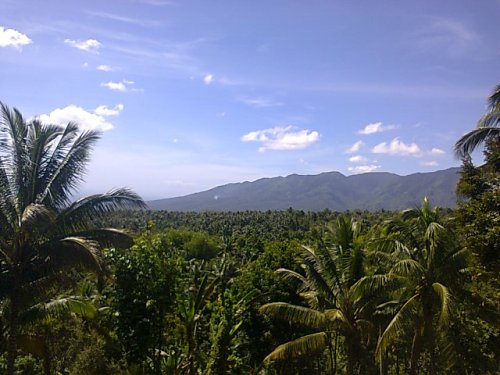











 Tuba is actually made from the sap of the flower.
Tuba is actually made from the sap of the flower.

 It was said to me on a few occasions that tuba is not good for people with high blood pressure. Well, generally throughout life, I have always failed tests, so I am particularly proud of the fact that every time I have had my blood pressure tested, I’ve come out with a good reading. After a few glasses of tuba, I would feel my blood pressure rising. I would go reddish and could be prone to the odd temper tantrum after drinking too much of it. The danger I experienced was liking the taste too much. It’s so sweet when fresh, too easy to drink and a half gallon could slip down my neck very quickly. It was also noticeable that very often on Sundays, which was the most sociable time in Catigan, fights would often break out among bickering drinkers. I also noticed that people tended to talk more shit than usual under its influence and probably myself, too. I soon learnt that the best place to indulge was at home.
It was said to me on a few occasions that tuba is not good for people with high blood pressure. Well, generally throughout life, I have always failed tests, so I am particularly proud of the fact that every time I have had my blood pressure tested, I’ve come out with a good reading. After a few glasses of tuba, I would feel my blood pressure rising. I would go reddish and could be prone to the odd temper tantrum after drinking too much of it. The danger I experienced was liking the taste too much. It’s so sweet when fresh, too easy to drink and a half gallon could slip down my neck very quickly. It was also noticeable that very often on Sundays, which was the most sociable time in Catigan, fights would often break out among bickering drinkers. I also noticed that people tended to talk more shit than usual under its influence and probably myself, too. I soon learnt that the best place to indulge was at home.